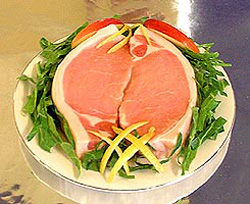Studies of Pork Shelf Life in Refrigerated Grocery Store Meat Cabinets
Early studies of pork suggested that surface temperature is a more important factor than exposure to light for the discoloration of pork and the growth of microorganisms on pork displays in refrigerated grocery store meat cabinets. However, the surface temperature of pork has been found to increase proportionately with the intensity of the lighting, regardless of whether the lamp is an incandescent or a cool white fluorescent lamp.
With all meat, even slight increases in surface temperatures accelerate oxidation and allow bacteria to grow exponentially, causing the meat to turn brown and to decompose. Later studies have shown that even with the lower levels of myoglobin in pork as compared to beef, pork is still sensitive to the oxidizing effects of light and will become discolored, turning brown or grey, after prolonged exposure to light and UV radiation, impacting sales even though this color change is not as dramatic as it is in cuts of beef.
The ideal storage temperature for pork is -1°C (30°F) for unwrapped meat or -1.5°C for wrapped meat, as the water within the muscle does not freeze substantially until -2°C, but spoilage bacteria grows slowly at -3°C with increasing rates as the temperature rises. With every temperature degree higher than the optimal storage temperature, shelf life is reduced by at least 10%. Therefore tiny temperature changes can drastically affect fresh pork shelf life; meat kept at -1.5°C will last twice as long as meat stored at 2°C.
In one study, more than thirty percent of pork cuts stored at 2°C and 5°C were judged to be unacceptable after being displayed for 24 to 30 hours, as compared to only 15% of pork stored at -1.5°C. Studies have found that surface temperatures of pork loin roasts are often at 10°C, and can vary from 4 to 25°C higher than the temperature of the refrigerated display case. Discoloration occurred more quickly for pork chops displayed under cool incandescent flood lights than pork displayed under other types of lights, in part because the intensity of the lighting increased the surface temperature by 3 to 14°F.
High temperatures affect pork in two ways. First, they contribute to the growth of microorganisms and discoloration. Second, pork fats are vulnerable to lipid oxidation leading to rancidity, which can occur when the pork is subjected to abusively high temperatures.
